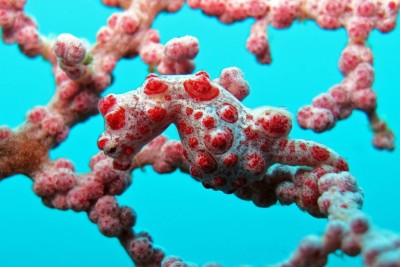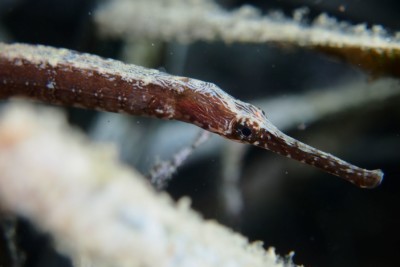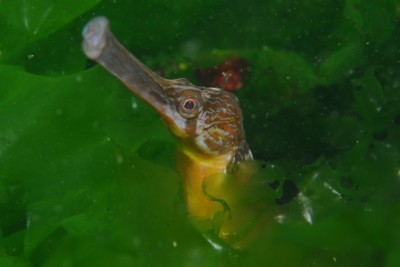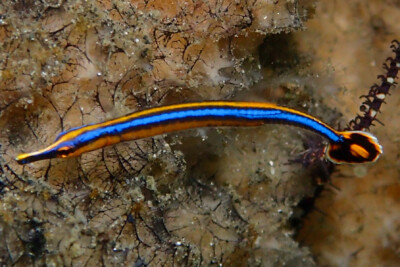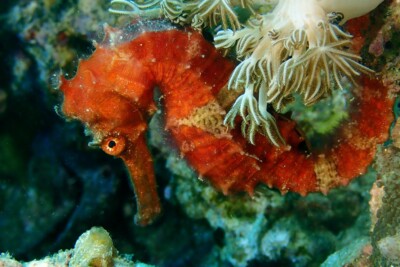denise's pygmy seahorse
| Scientific name | Hippocampus denise |
|---|---|
| Descriptor | Lourie & Randall |
| Year of description | 2003 |
| IUCN category (World) | LC |
| Family | Syngnathidae |
| Genus | Hippocampus |


Introduction
Denise's Pygmy Seahorse is one of the smallest seahorses in the world. It was named in honor of Denise Tackett, who discovered and photographed the species. It is found in the tropical waters of the western Pacific Ocean.
This camouflage expert has a coloration and tubercle-shaped body, perfectly mimicking the stems and polyps of its host gorgonians.
Who is it?
Morphology
-
Type
-
Average size2 cm
-
Maximum size3 cm
-
Type
-
Average size2 cm
-
Maximum size3 cm
How to recognize This fish ?
Described in the early 2000s, Denise's Pygmy Seahorse is one of the smallest known seahorse species. Barely visible, it measures less than 2 cm in length.
The body is relatively thin and fleshy. Small prominences can be seen on the lower and ventral parts of the trunk. The neck is rounded without an elevated crown unlike other small seahorse species. The neck is long and the snout is short without tubercles. The tail is prehensile.
Unlike other seahorse species, it does not have spines above the eye.
Its characteristic color is orange, with darker rings around the tail. The shape and coloration allow it to blend in with the stems and polyps of its hosts.
It is sometimes confused with other species.
Sexual dimorphism
Females are also thin and elongated, while males are more rounded.
Behaviour & Life cycle
-
dietcarnivorous
-
Sociabilityliving as a couple or alone
-
territorialNo
-
Way of livingdiurnal
This seahorse is found in reef areas. It has been observed and photographed at depths of 13 to 90 m in association with sea fans identified as Annella reticulata, Muricella sp., and Echinogorgia.
Its lifestyle is still poorly studied.
Reproduction
-
Reproductionovovivipare
This species is monogamous and ovoviviparous.
Males and females perform a courtship ritual before the female deposits eggs in the male's pouch located under the tail. This pouch has villi with capillaries surrounding each egg, providing nourishment to the embryos.
Harmless species
This species does not represent any particular threats to humans when encountered in its natural environment.
Origin and distribution
Geographic distribution & Conservation
Its distribution range apparently extends beyond Indonesia, Vanuatu, and Palau.
This fish has also been spotted in Malaysia, the Solomon Islands, and Micronesia. In 2011, a first observation was made in the Great Barrier Reef.
Conservation status of populations (IUCN)
What is its habitat?
Natural environment characteristics
-
Temperature24 - 28 °C
-
Depth13 - 90 m
-
EnvironmentActive pelagic
-
FlowSlow
Biotope presentation
The species is found in reefs at depths between 13 and 90 meters.
Species of the same biotope
Fishkeeping
Not recommended
We do not recommend keeping this species in an aquarium. It has unpredictable needs which, if not met, generate significant stress, potentially leading to a shorter life expectancy, an interruption of its growth or the development of pathogens.
To go further
Sources & Contributions
Participation & Validation
The Fishipedia team and specialist contributors are committed to providing high-quality content. However, although the information comes from scientific sources or testimonials from specialists, the cards may contain inaccuracies.

Silvia Gomez

Benoit Chartrer
Translation
Translation done with the valuable contribution of our translators, who make this information available to a wider audience. We sincerely thank them for their commitment.
Scientific partners
Tags
Species of the same family
Same genus
Species of the same biotope






